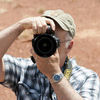will 300 dpi be enough?
Mar 23, 2014 12:49:57 #
I in the process of scanning some old pictures from my film days. Now wondering if 300 dots per inch will be big enough to blow up a picture to be able to make a poster out of it.
Mar 23, 2014 12:57:24 #
300 will work for like size reproductions. Higher resolution will be needed for enlarging.
Mar 23, 2014 13:04:17 #
MT Shooter wrote:
300 will work for like size reproductions. Higher resolution will be needed for enlarging.
Not sure I agree with that. OP said dpi. Assuming dpi (not ppi) one can easily create images larger than original with same degree of integrity. It depends on how the enlargement is made and how good the original photo is.
Mar 23, 2014 13:08:41 #
No. 600dpi is a minimum standard for printed photographs. I am afraid at 300dpi you will end up scanning them again.
Mar 23, 2014 13:31:20 #
MT is correct. If you scan a 4x6 image at 300dpi you will have a 4x6 image that will print correctly at 4x6. If you have a 4x6 that you'd like to view and print a little larger you'll want to increase the dpi. I'd always choose the highest your scanner can do for the highest quality. Do not confuse dpi with ppi. The dpi will set the image size and ppi is what you choose when ready to print the image. Most people use somewhere around 300ppi to print, but large (20x30) or larger prints can be printed with fewer ppi but the closer to 300ppi is better. Larger prints can be printed with few ppi because you usually view them from greater distances.
MT Shooter wrote:
300 will work for like size reproductions. Higher resolution will be needed for enlarging.
Mar 23, 2014 13:34:43 #
charryl wrote:
Not sure I agree with that. OP said dpi. Assuming dpi (not ppi) one can easily create images larger than original with same degree of integrity. It depends on how the enlargement is made and how good the original photo is.
Scanners and printers both use "dpi", the correlation is direct. If you scan a 4x6 print at 300dpi and try to print it at 8x12 size, you will be printing at 72dpi, not something you are likely to want to show anyone.
Mar 23, 2014 15:06:32 #
OK! I've been playing with this and am able to bump up my dpi's to 600 dpi. I have been also playing with image size. My software is paint Shop Pro X4. It will only make the photo 16"x16" I want to be able to make it poster size. I never really played around with image size much. MT shooter said that @ @300dpi I will be printing at 72dpi,@ 600dpi I should have 144dpi for printing. Will that be enough for a poster?
Mar 24, 2014 07:55:06 #
Mar 24, 2014 08:43:45 #
Mar 24, 2014 10:13:26 #
MT Shooter wrote:
Scanners and printers both use "dpi", the correlation is direct. If you scan a 4x6 print at 300dpi and try to print it at 8x12 size, you will be printing at 72dpi, not something you are likely to want to show anyone.
Dpi, ppi, and resolution are three different elements and are often confused and often used interchangeably. I shoot at high resolution but I always print between 230 and 380 dpi. Lower than 230 and the human eye distinguishes spaces between the dots on the printed paper and higher than 380 and you are just wasting ink. If the resolution from the scan is 72 ppi, then the image is going to be difficult to get a good print from much less increasing image size. This is an absolute aside and nothing to do with dpi or ppi but has everything to do with how the human eye and brain work. Salvidore Dali learned that the human brain can discern an image consisting of only 21 pixels. His painting, Gala Contemplating the Mediterranean Sea which at Twenty Meters Becomes the Portrait of Abraham Lincoln, is a perfect example of this. Up close the painting is of his beautiful wife looking out over the Sea. step back 20 meters and now it is a portrait of Lincoln...Gala is no longer visible to the human eye.
Mar 24, 2014 10:20:19 #
charryl wrote:
Dpi, ppi, and resolution are three different eleme... (show quote)
Please read my explanation again, you are clearly misunderstanding the math. AND we are talking DPI here, not PPI. Scanners scan at DPI. If you scan a 4x6 at 300 DPI, that's the file you have. If you want an 8x12 print from that file, enlarging the dimensions scanned to that print size is a 4X increase in area, which will require reducing your image data to 1/4. That will result in an image that is only 75 dpi in size and will not yield a good quality print. You should never scan any print at 72dpi as it will only yield an image that can be viewed on a monitor at full size, but never printed at full size. This discussion has nothing to do with taking a digital image, but is only about digitizing an analog image to reprint from that digital file so trying to read anything about PPI into it is only confusing anyone reading here.
Mar 24, 2014 10:46:42 #
MT Shooter wrote:
Please read my explanation again, you are clearly ... (show quote)
Must be a difference in scanners then because my scanner definitely scans in ppi. (J checked to make sure I wasn't dreaming). In photoshop I can convert to dpi but the resolution is the resolution. I get a bigger bad image if the resolution is poor in the original scanned image.)
Mar 24, 2014 10:55:38 #
charryl wrote:
Must be a difference in scanners then because my scanner definitely scans in ppi. (J checked to make sure I wasn't dreaming). In photoshop I can convert to dpi but the resolution is the resolution. I get a bigger bad image if the resolution is poor in the original scanned image.)
I have Canon and Epson scanners and they both scan in dpi. Other than that we agree.
I did have an old Nikon Coolscan film scanner, and it scanned in ppi.
Apr 1, 2014 19:17:48 #
thepicturesnapper wrote:
I in the process of scanning some old pictures from my film days. Now wondering if 300 dots per inch will be big enough to blow up a picture to be able to make a poster out of it.
Reguardless of the dpi you may need to "interpolate" it up to a larger size...add more pixels depending on how big you want to go.
Apr 1, 2014 20:35:07 #
hpl575
Loc: Indianapolis, IN
Most quality printers are printing well beyond 300dpi. The software and firmware are rendering the printed image points in between and will start to complain if the number of actual pixels divided by the printed dimension is less than 240 give or take, true for a scan or sensor.
Further complicating the issue is the printed photo may not have a resolution of 300dpi. Depends on a lot of factors, original lens, film, enlarger, etc. Increasing the scan dpi will not improve anything other than stopping the software from complaining. Also, consumer grade scanners never seem to be able to actually resolve the advertised dpi.
I've had the best luck having the film professionally scanned, even this has several levels of quality.
There is software to upscale and then tweak. Software to "posterize", opposite the way it appears you want to go is common in a lot of edit programs.
Good luck, not an easy task.
Further complicating the issue is the printed photo may not have a resolution of 300dpi. Depends on a lot of factors, original lens, film, enlarger, etc. Increasing the scan dpi will not improve anything other than stopping the software from complaining. Also, consumer grade scanners never seem to be able to actually resolve the advertised dpi.
I've had the best luck having the film professionally scanned, even this has several levels of quality.
There is software to upscale and then tweak. Software to "posterize", opposite the way it appears you want to go is common in a lot of edit programs.
Good luck, not an easy task.
If you want to reply, then register here. Registration is free and your account is created instantly, so you can post right away.





